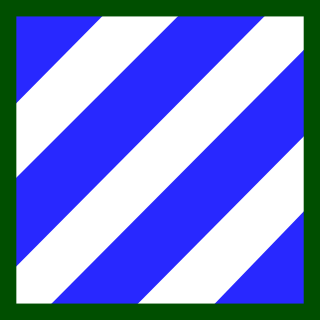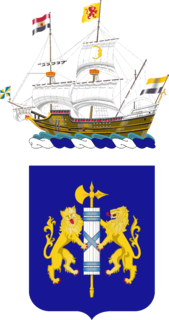
The 3rd Infantry Division is a combined arms division of the United States Army based at Fort Stewart, Georgia. It is a direct subordinate unit of the XVIII Airborne Corps and U.S. Army Forces Command. Its current organization includes a division headquarters and headquarters battalion, two armored brigade combat teams, one National Guard infantry brigade combat team, one task force battalion, one aviation brigade, a division artillery, a sustainment brigade and a combat sustainment support battalion along with a maneuver enhancement brigade. The division has a distinguished history, having seen active service in World War I, World War II, the Korean War, Vietnam War, and the Global War on Terror. The Medal of Honor has been awarded to 61 members of the 3rd Infantry Division, making the division the most honored in the Army.

The 40th Infantry Division is a modular division of the United States Army. Following the army's modularization the division has become a four-brigade combat team with National Guardsmen from throughout the Pacific/Western United States and Oceania. Its division headquarters is located at Los Alamitos Joint Forces Training Base in Los Alamitos, California.

The 86th Infantry Division was a unit of the United States Army in World War I and World War II. Currently called the 86th Training Division, based at Fort McCoy, Wisconsin, members of the division now work with Active Army, Reserve, and National Guard units to provide them with a Decisive Action Training Environment on a yearly basis.

The 43rd Infantry Division was a formation of the United States Army from 1920 to 1963, serving in the Pacific during World War II. It was activated in 1920 as a National Guard Division in Connecticut, Maine, Rhode Island, and Vermont. The 143rd Regional Support Group of the Connecticut National Guard now carries on the heritage.

The 6th Infantry Division was an infantry division of the United States Army active in World War I, World War II, and the last years of the Cold War. Known as "Red Star", it was previously called the "Sight Seein' Sixth".

The 38th Infantry Division ("Cyclone") is one of the eighteen divisions of the United States Army, and one of eight National Guard divisions. It is headquartered in Indianapolis, Indiana, and contains Army National Guard units from Indiana, Ohio, Kentucky, Delaware, Michigan, Tennessee and Other States.

The 37th Infantry Division was a unit of the United States Army in World War I and World War II. It was a National Guard division from Ohio, nicknamed the "Buckeye Division". Today, its lineage is continued through the 37th Infantry Brigade Combat Team, with battalions from Ohio, Michigan, and South Carolina.

The 33rd Infantry Division was a formation of the U.S. Army National Guard between 1917 and 1968. Originally formed for service during World War I, the division fought along the Western Front during the Battle of Amiens, the Battle of Hamel, the Meuse-Argonne Offensive, at the Second Battle of the Somme, and at the Battle of Saint-Mihiel. It was re-formed during the inter-war period, and then later activated for service during World War II, seeing action against the Imperial Japanese Army in the Pacific. In the post war era, the division was reconstituted as an all-Illinois National Guard division. In the late 1960s, the division was reduced to a brigade-sized formation, and its lineage is currently perpetuated by the 33rd Infantry Brigade Combat Team.

The 27th Infantry Division was a unit of the Army National Guard in World War I and World War II. The division traces its history from the New York Division, formed originally in 1908. The 6th Division designation was changed to the 27th Division in July 1917.

The 28th Infantry Division ("Keystone") is a unit of the Army National Guard and is the oldest division-sized unit in the Department of Defense. Some of the units of the division can trace their lineage to Benjamin Franklin's battalion, The Pennsylvania Associators (1747–1777). The division was officially established in 1879 and was later redesignated as the 28th Division in 1917, after the entry of America into the First World War. It is today part of the Pennsylvania Army National Guard, Maryland Army National Guard, Ohio Army National Guard, and New Jersey Army National Guard.

The Philippine Army (PA) is the main, oldest and largest branch of the Armed Forces of the Philippines (AFP), responsible for ground warfare and as of 2021 had an estimated strength of 101,000 soldiers backed by 100,000 ready reserves. The service branch was established on December 21, 1935, as the Philippine Commonwealth Army. The Philippine Army has engaged in many conflicts including the ongoing Communist rebellion in the Philippines, the Moro conflict and, alongside other national military forces, in conflicts of international scope.

The 26th Infantry Division was an infantry division of the United States Army. A major formation of the Massachusetts Army National Guard, it was based in Boston, Massachusetts for most of its history. Today, the division's heritage is carried on by the 26th Maneuver Enhancement Brigade.

The 145th Armored Regiment, Ohio Army National Guard, is a parent regiment under the U.S. Army Regimental System, with headquarters at Stow, Ohio. It currently consists of the 1st Battalion, 145th Armored Regiment, a 600-soldier combined arms battalion of the Ohio Army National Guard located throughout northeast Ohio.
The 161st Infantry Regiment is an infantry regiment of the United States Army and the Washington Army National Guard. It is the oldest unit in the Washington Army National Guard tracing its lineage to the separate Infantry Companies of the Territorial Militia. Its 1st Battalion is a combined arms element of the 81st Stryker Brigade Combat Team consisting of two infantry and two armored companies, with its headquarters in Spokane, Washington.

The 108th Infantry Regiment is a regiment of the New York Army National Guard. It was first formed in 1898 and has been in continuous existence since 1907. As National Guardsmen, Soldiers of the 108th Infantry can be called upon to serve the state and federal governments. The 108th has served in the Spanish–American War, the Mexican Border War, World War I, World War II, Iraq, and Afghanistan.

The 3rd Battalion, 172nd Infantry Regiment (Mountain), also known as the "Mountain Battalion", is a Vermont Army National Guard light infantry battalion which specializes in mountainous and cold weather operations. The unit falls under the command of the Vermont Army National Guard's 86th Infantry Brigade Combat Team (Mountain).
The 152nd Infantry Regiment is an infantry regiment in the Indiana Army National Guard, part of the 76th Infantry Brigade Combat Team.

The 133rd Engineer Battalion is a component of the Maine Army National Guard and the United States Army. The organization is the oldest in the Maine Guard and is one of the largest organizations in the state. The battalion has responded to natural disasters at home as well as military actions overseas. The current battalion has the capacity to execute a variety of Army Engineer missions, from horizontal construction, vertical construction, combat engineer missions, and surveying. The battalion has two horizontal companies, one vertical company, one combat engineer company, a forward support company, a survey and design detachment, and a headquarters company.

The 169th Infantry Regiment was an infantry regiment of the United States Army, Connecticut National Guard. They trace their ancestry back to when militia units in the Connecticut colony organized for drill in 1672, but their official organization as the 1st Connecticut occurred on 11 October 1739. Since then, the 169th and its predecessor units have fought in numerous American wars until its deactivation in 1992.



















